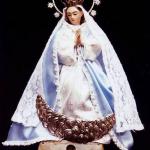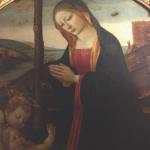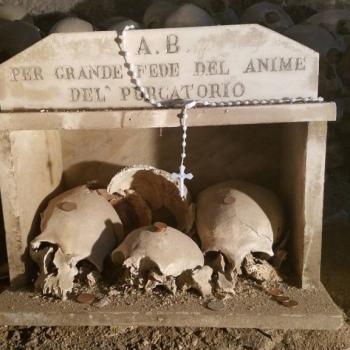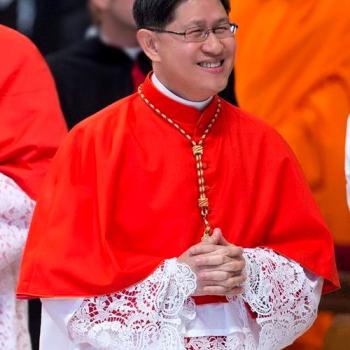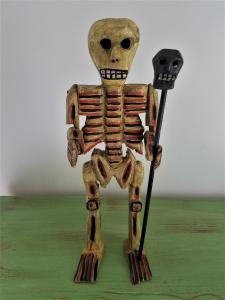
Co-authored by Dr. Andrew Chesnut and Dr. Kate Kingsbury*
Guatemalan folk saint Rey Pascual’s foundation myth is a fascinating account of Catholic and Mayan syncretism in which the original Spanish saint, Pascual Bailón, morphs into the skeletal folk saint who is venerated today in Olintepeque and also Tuxtla Gutiérrez, the capital of Chiapas, Mexico’s southernmost state. A canonized saint whose feast day is May 17, Pascual Bailón was a Franciscan friar from Aragón who lived during the second half of the sixteenth century and was known as a mystic and contemplative. He was beatified by the Church in 1618, just a couple decades after his death, and then canonized in 1690. Although he never set foot in the Americas, his purported apparition in Guatemala in 1650 to a deathly ill Mayan man is credited with ending a virulent epidemic.
Origins: Rey Pascual
Legend has it that the Spanish holy man, the patron saint of cooks, appeared in the form of a tall skeleton in luminescent robes at the deathbed of a prominent Kaqchikel man and presented himself as Saint Pascual, even though it would be forty more years until he was canonized. In the classic quid pro quo relationship that pervades grassroots religion in Latin America, the skeletal saint offered to end the epidemic in the Kaqchikel region of present-day Ciudad Vieja, Sacatepéquez, if the community adopted him as their patron saint.
As proof of his saintly powers, Pascual predicted that in nine days the recipient of the vision would succumb to his high fever and at the same time the epidemic would run its course. As word of the Aragonese saint’s correct prediction spread, his image, much to the dismay of the Spanish Inquisition, became increasingly popular in the region during the colonial period. Over time Rey Pascual has expanded his repertoire from faith healing to the multitasking miracle worker that he is today. However, his first miracle as the new skeletal folk saint in Guatemala of eradicating disease remains at the core of his present-day mission.
Santa Muerte and Syncretism
As bizarre as the case of Catholic-Mayan syncretism might seem, it is not unique in Latin America. In fact, Catholic syncretism with other the religious traditions of other indigenous groups, including African faiths, was the norm. For example, the image of Mexican Skeleton Saint, Santa Muerte from the small town of Tepatepec, Hidalgo, is fused with the image of Saint Bernard (San Bernardo Clairvaux), the medieval French holy man whom local Catholics associated with the skeletal figure of death. One of the oldest and most unique representations of Santa Muerte, a wooden statue that is now venerated at the Cruz family shrine, is about four feet tall and is usually dressed like a queen with a satin robe, crown, and scepter in her left hand.
Unlike most statues of the skeleton saint, which depict her standing, this one is seated on a wooden chair. Particularly striking is the wooden idol’s mummified-looking face. This isn’t the Bony Lady’s typical skinless skull but rather a fleshy face with an elongated mouth that appears to be stitched shut. The Cruz family apparently had the two- hundred- year- old image in their possession for several generations, going back at least until the late nineteenth century. The octogenarian matriarch of the family reported that her great-grandparents used to lend out the image for Holy Week processions in which it rode seated in a cart along with figures of Christ of the Holy Sepulcher and the Virgin Mary. Believing it to be the likeness of Saint Bernard, devotees would also parade the statue through the town on August 20 in celebration of the feast day of the French saint. Though devotees no longer parade her through the town as part of Holy Week, they continue to celebrate the same August feast day.
Indigenous Religion: Polytheistic Pantheons for a Purpose
In order to better comprehend the popularity and wide range of folk saints in Meso-America, it is vital to examine the history of the region as well as pre-Hispanic modes of religious worship. Although there has been much change, given the shift to Catholicism, there also remains continuity with the praxis and doxa of the pre-colonial past. Prior to the imposition of Catholicism, the Aztec, Mayan, Mixtec, Zapotec and other Meso-American indigenous groups had polytheistic religions. These peoples turned to a wide variety of deities and spirits whom they addressed in correlation with their prevailing concern. Rather than elevated gods, more often than not, local spirits were turned to. Indigenous peoples might turn to different deities at different times. For example amongst the Mixtec, Dzahui was the deity of rain. Dzahui was supplicated during times of drought and leading up to the harvest. However if too much rain was inundating the fields, the Mixtec might turn to Lord One Death, the sun deity, petitioning him for his generative rays. These deities were most popular with farmers, whilst for merchants Yozotoyua was the divinity most often given oblations, as he was said to ensure commercial success.
Whilst conducting fieldwork in the region, it became clear that many locals considered the Catholic God an abstract figure or a power too far removed from daily life to be propitiated for favours. Yet individual Saints were frequently mentioned in conversation, akin to members of the family, they were considered familiar and approachable for aid. These saints and folk saints had life stories that imbued them with a sense of proximity and even intimacy. Like the indigenous deities who preceded them, they too possessed unique attributes and skills, and thus could be petitioned for particular favours. Although increasingly we see Folk Saints such as Santa Muerte who are multitaskers ostensibly manifesting manifold miracles for devotees, most Meso-American saints and folk saints have a distinct skill set. For example, Our Lady of the Bullet, is a Marian figure turned to especially by Mexican women who seek her protection, for her purported ability to shield those at risk, living in violent areas, from the stray bullets of criminals and drug gangs. Rey Pascual, as we have seen, is turned to by the sick or their families for his salutary sacred powers.
Home Altars: an Ancient Practice
Numinous practices today resemble those of pre-Hispanic times. In the past amongst indigenous peoples, such as amongst the Mixtec and Zapotec, religion was characterised by offerings and sacrifices of copal, feathers, resins, blood and other similar items. Libations and supplications took place usually at a home altar which featured a stone idol that represented the deity, offering vessels and other sacrificial material culture. Those who turn to modern day folk saints, such as Santa Muerte or Rey Pascual, mimic their ancestors’ movements, for typically their veneration involves a home altar, at the centre of which is a representation of their saint, surrounded by offerings of sacrificial items, such as votive candles, tobacco, alcohol, flowers, food and other items. Some folk saints are said to have particular preferences for specific items, for example tequila is said to be appreciated by the Skeleton Saint, whilst San Simon, also known as Maximon, is frequently given cigars and is said to aid with financial success.
The Pervasiveness of Faith
Religion in our era remains as inevitable and enduring as the arts, music or philosophy. The apparent inherent desire for Meso-American people to prioritize and propitiate a pantheon of saints and folk saints in alignment with current daily concerns reminds us that despite the imposition of new modes of religion, new modus vivendi, the impetus and mechanisms underlying modern day numinous customs and beliefs are movements and convictions that have long been essential ways of being in and coping with the trials and tribulations of existence in the world and that these religious deeds have been repeated since time immemorial and will continue to be reiterated with infinite variation long into the future.
Dr. Kate Kingsbury obtained her doctorate in anthropology at the University of Oxford, where she also did her Mphil. Dr. Kingsbury is a polyglot fluent in English, French, Spanish. She is a polymath interested in exploring the intersections between anthropology, religious studies, philosophy, sociology and critical theory. Dr. Kingsbury is Adjunct Professor at the University of Alberta, Canada. She is fascinated by religious phenomena, not only in terms of their continuity across the Holocene and into the Anthropocene but equally interested in the changes wrought to praxis and belief by humans ensuring the infinite esemplasticity that is inherent to all religions, allowing for their inception, survival, alteration, regeneration and expansion across time and space. Dr. Kingsbury is a staunch believer in equal rights and the power of education to ameliorate global disparities. She also works pro bono for a non profit organisation that aims to empower and educate girls in Uganda. Follow Dr. Kingsbury on Twitter.


